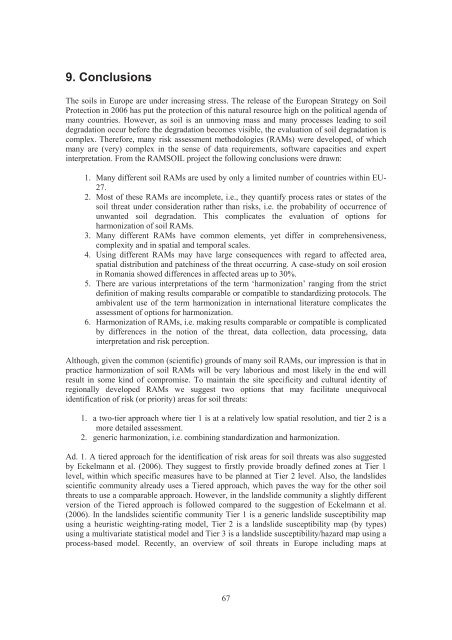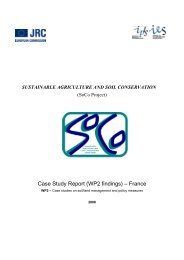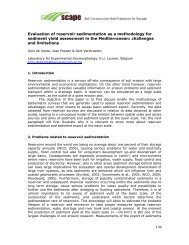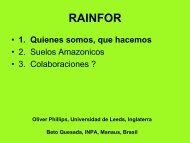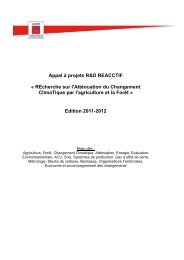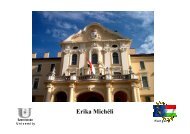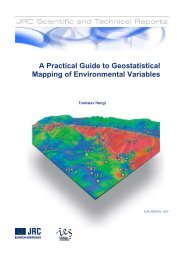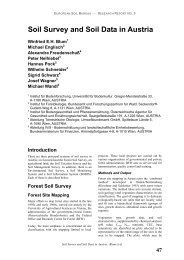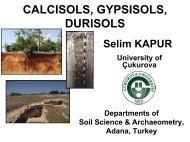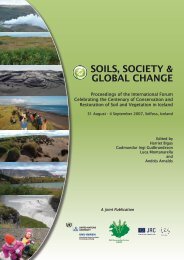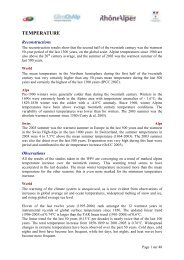Risk Assessment Methodologies of Soil Threats in Europe
Risk Assessment Methodologies of Soil Threats in Europe
Risk Assessment Methodologies of Soil Threats in Europe
You also want an ePaper? Increase the reach of your titles
YUMPU automatically turns print PDFs into web optimized ePapers that Google loves.
9. Conclusions<br />
The soils <strong>in</strong> <strong>Europe</strong> are under <strong>in</strong>creas<strong>in</strong>g stress. The release <strong>of</strong> the <strong>Europe</strong>an Strategy on <strong>Soil</strong><br />
Protection <strong>in</strong> 2006 has put the protection <strong>of</strong> this natural resource high on the political agenda <strong>of</strong><br />
many countries. However, as soil is an unmov<strong>in</strong>g mass and many processes lead<strong>in</strong>g to soil<br />
degradation occur before the degradation becomes visible, the evaluation <strong>of</strong> soil degradation is<br />
complex. Therefore, many risk assessment methodologies (RAMs) were developed, <strong>of</strong> which<br />
many are (very) complex <strong>in</strong> the sense <strong>of</strong> data requirements, s<strong>of</strong>tware capacities and expert<br />
<strong>in</strong>terpretation. From the RAMSOIL project the follow<strong>in</strong>g conclusions were drawn:<br />
1. Many different soil RAMs are used by only a limited number <strong>of</strong> countries with<strong>in</strong> EU-<br />
27.<br />
2. Most <strong>of</strong> these RAMs are <strong>in</strong>complete, i.e., they quantify process rates or states <strong>of</strong> the<br />
soil threat under consideration rather than risks, i.e. the probability <strong>of</strong> occurrence <strong>of</strong><br />
unwanted soil degradation. This complicates the evaluation <strong>of</strong> options for<br />
harmonization <strong>of</strong> soil RAMs.<br />
3. Many different RAMs have common elements, yet differ <strong>in</strong> comprehensiveness,<br />
complexity and <strong>in</strong> spatial and temporal scales.<br />
4. Us<strong>in</strong>g different RAMs may have large consequences with regard to affected area,<br />
spatial distribution and patch<strong>in</strong>ess <strong>of</strong> the threat occurr<strong>in</strong>g. A case-study on soil erosion<br />
<strong>in</strong> Romania showed differences <strong>in</strong> affected areas up to 30%.<br />
5. There are various <strong>in</strong>terpretations <strong>of</strong> the term ‘harmonization’ rang<strong>in</strong>g from the strict<br />
def<strong>in</strong>ition <strong>of</strong> mak<strong>in</strong>g results comparable or compatible to standardiz<strong>in</strong>g protocols. The<br />
ambivalent use <strong>of</strong> the term harmonization <strong>in</strong> <strong>in</strong>ternational literature complicates the<br />
assessment <strong>of</strong> options for harmonization.<br />
6. Harmonization <strong>of</strong> RAMs, i.e. mak<strong>in</strong>g results comparable or compatible is complicated<br />
by differences <strong>in</strong> the notion <strong>of</strong> the threat, data collection, data process<strong>in</strong>g, data<br />
<strong>in</strong>terpretation and risk perception.<br />
Although, given the common (scientific) grounds <strong>of</strong> many soil RAMs, our impression is that <strong>in</strong><br />
practice harmonization <strong>of</strong> soil RAMs will be very laborious and most likely <strong>in</strong> the end will<br />
result <strong>in</strong> some k<strong>in</strong>d <strong>of</strong> compromise. To ma<strong>in</strong>ta<strong>in</strong> the site specificity and cultural identity <strong>of</strong><br />
regionally developed RAMs we suggest two options that may facilitate unequivocal<br />
identification <strong>of</strong> risk (or priority) areas for soil threats:<br />
1. a two-tier approach where tier 1 is at a relatively low spatial resolution, and tier 2 is a<br />
more detailed assessment.<br />
2. generic harmonization, i.e. comb<strong>in</strong><strong>in</strong>g standardization and harmonization.<br />
Ad. 1. A tiered approach for the identification <strong>of</strong> risk areas for soil threats was also suggested<br />
by Eckelmann et al. (2006). They suggest to firstly provide broadly def<strong>in</strong>ed zones at Tier 1<br />
level, with<strong>in</strong> which specific measures have to be planned at Tier 2 level. Also, the landslides<br />
scientific community already uses a Tiered approach, which paves the way for the other soil<br />
threats to use a comparable approach. However, <strong>in</strong> the landslide community a slightly different<br />
version <strong>of</strong> the Tiered approach is followed compared to the suggestion <strong>of</strong> Eckelmann et al.<br />
(2006). In the landslides scientific community Tier 1 is a generic landslide susceptibility map<br />
us<strong>in</strong>g a heuristic weight<strong>in</strong>g-rat<strong>in</strong>g model, Tier 2 is a landslide susceptibility map (by types)<br />
us<strong>in</strong>g a multivariate statistical model and Tier 3 is a landslide susceptibility/hazard map us<strong>in</strong>g a<br />
process-based model. Recently, an overview <strong>of</strong> soil threats <strong>in</strong> <strong>Europe</strong> <strong>in</strong>clud<strong>in</strong>g maps at<br />
67


